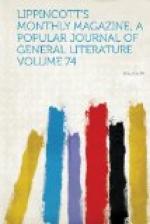The next day, Sunday, Kathi stood before us at noon with tears in her eyes. The Jakobi, she said, had not only sent down for the cow’s crown and ornaments to go on Tuesday, but word as well that beautiful Nageli, the queen cow, knocking her head against a rock, had broken one horn off. “There’s a pretty go!” she continued. “I wish it would bud again. How she will take on! I know her ways: she is greedy of praise. I should not wonder if the vexation dries her milk, for she knows she can never wear a crown again. And Zottel, she’s to be queen—a sleek, comely cow, but never used to a crown. However, Jakobi sends word we need not fear her disgracing herself, for he is training her up and down with a milking-stool on her head. Cows are more like mortals than brute beasts. See the way the two that have stayed at the Hof behave when the rest come back. They make the stall purgatory to them through their spite or jealousy. But they grow more good-tempered after a time.”
The glittering crown of which poor Nageli’s unfortunate accident had deprived her was now produced from its box for us to see—a barbaric structure, in spite of the Christian symbols attached. It was two feet high, a foot and a half wide—all gold wire, tinsel, artificial flowers, tassels, fringes of colored worsted, and surrounded by a halo of spun glass gay as a slice of the rainbow. There was a medallion of the Virgin and Child, and another of Saint Anthony, tutelar saint of the Hofbauer’s father, himself and his son—patron, too, of the chapel, and a great helper in the recovery of lost calves and sheep, as well as of household goods. A red velvet gold-fringed pendant in the form of a heart, handsomely embroidered with the cross and sacred initials I.H.S., was suspended to all this grandeur. The great massive cow- and ox-bells, some tulip-shaped, while others were of the ordinary form, appeared better adapted for a belfry than the neck of cattle, and the gay leather collars, embroidered with bright worsteds, had likewise sacred symbols; thus displaying, when worn at the annual procession, both the pride and piety of the bauer.
The wreaths made at the Olm for the chief oxen, of clustering berries, leaves and ribbons, hung, as visible though withered trophies of each triumphant descent, amongst the rakes, flails and other farm implements in the lower hall; whilst great closets safely hid not only the bells and the rest of the substantial properties now to be despatched to the Olm, but other brazen pomps and vanities of an age gradually becoming obsolete—the heavy harness, for instance, used for the bridal horse when the Hofbauer was married—antiquities suitable for a national museum. The good aunt and Moidel, amused by our interest and astonishment, attired the latter the same evening, for our gratification, in her mother’s wedding-dress. Strong indeed must be the bride who can bear so heavy a burden, nor would any but a Tyrolese girl desire thus to be




